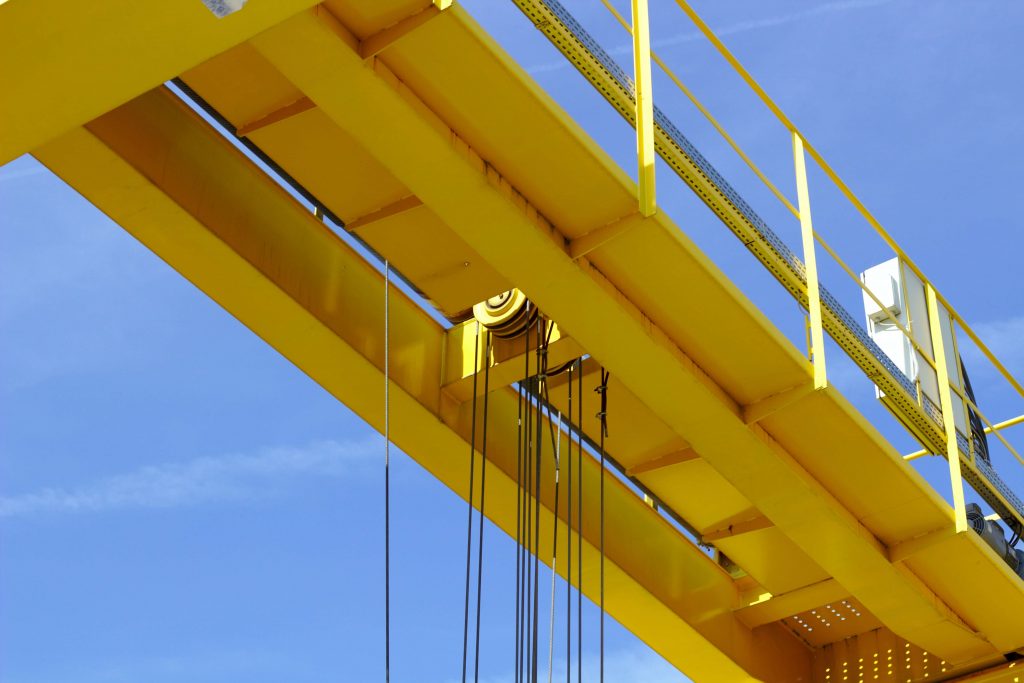
At Sussex Transport, we pride ourselves on our expert knowledge of the industrial, lifting, construction and transport industries.
As well as Lorry Loader Crane Services, our in-house experts offer training and qualifications for both experienced and novice professionals on alternative crane types.
Today, we wanted to focus on Overhead Gantry Crane training.
What Is An Overhead Gantry Crane?
A gantry crane is an overhead crane supported by freestanding legs with a single or double girder configuration.
These cranes are often on wheels or run along a track system.
Typically, overhead gantry cranes are used for outdoor applications like vehicle loading – but can also be found in warehouses and facilities where heavy goods are often shifted and lowered into position for operational purposes. An example would be an injection moulding company where heavy mould tools are lifted carefully into moulding machines.
Because they don’t need to be tied to a building’s support structure (we’ll talk more about this below), they can often provide a much more cost-effective alternative to bridge cranes.
What is Overhead Gantry Crane Training?
To ensure the safety of your team, it is vital for anyone using heavy industrial machinery to have appropriate training.
Every crane is different. They require unique skills to safely and expertly operate.
Overhead Gantry cranes are no different. Our training will help workers learn:
- Health and safety legislation, as it applies to Overhead Gantry Crane Operators.
- Theoretical knowledge of Overhead Gantry Cranes.
- Operator’s responsibilities, with regards to daily/weekly checks of the machine.
- Familiarity with the equipment and use of the Operator’s manual.
- Safe and best practice in practical operating methods either with pendant or remote-control operated Overhead Gantry Cranes.
The course will involve both practical and theoretical elements, resulting in either an NPORS or Sussex Transport | Training Division accreditation for those who pass.
Why Is Overhead Gantry Crane Training Important?
As alluded to above, ensuring workers are professionally trained and qualified to operate an overhead gantry crane can help the overall safety of your team.
Training can reduce the risk of accidents which could otherwise have devastating consequences.
And if trained operators correctly use the equipment, it will likely last much longer, thus saving you money by not having to place or repair expensive machinery further down the line.
Are There Any Differences Between An Overhead Crane And A Gantry Crane?
Both gantry cranes and overhead cranes are very similar.
They can both lift and lower things(!); they can both be used in an indoor setting, and they can be operated both manually and electrically.
So, are there any differences?
Well, yes, there is one main difference, and that’s portability.
An overhead crane (also known as a bridge crane) is attached to the interior structure of a building. It is mounted onto girders that support the roof and walls of said building.
Overhead cranes are, therefore, a permanent installation in places like factories and warehouses.
Gantry cranes, meanwhile, are more versatile.
They are supported by their own A-frames and usually mounted on a tracking system.
As a result, they are far easier and quicker to assemble than overhead cranes and can be moved from site to site (as well as used both indoors and outdoors).
Which Is Stronger: An Overhead Crane Or A Gantry Crane?
Because of their structure and how they are mounted into a building’s frame, overhead cranes have the highest maximum lifting capacity.
That’s not to say that gantry cranes aren’t powerful.
They are, but their mobility can give them the edge over bridge cranes (depending on job requirements), and their potential versatility can also make them more cost-effective.
Summary
Overhead and gantry cranes are fantastic heavy-lifting devices.
Due to their nature, specific training and qualifications are needed to ensure they are operated correctly. This can help protect your team’s safety and potentially reduce long-term repair costs.
And while very similar in terms of looks and usability, the main difference between an overhead crane and a gantry crane is portability: gantry cranes are more mobile and versatile.
If you would like to find out more information about our gantry crane training, contact Sussex Transport today.